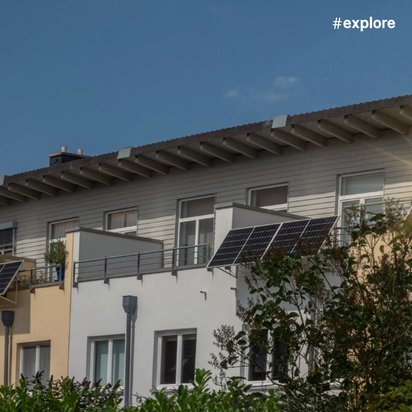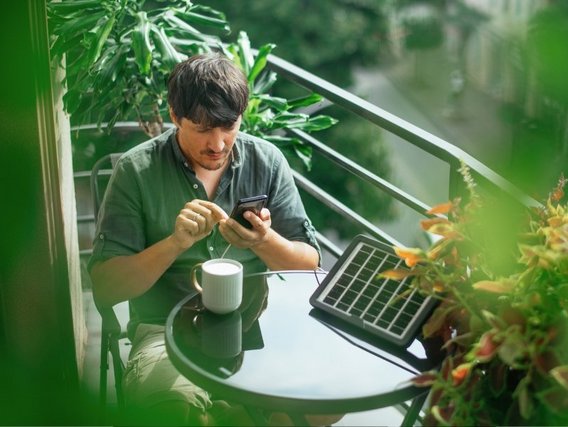Checklist
Sun from the balcony
What mini solar systems offer and how their installation is to be simplified.

Checklist
What mini solar systems offer and how their installation is to be simplified.

26 October 2023
With solar systems for balconies or gardens, even people in cities can generate their own electricity with ease. The federal government now aims to reduce bureaucratic and technical hurdles for balcony power plants. Our checklist answers the most important questions about these small solar systems.

What Are Mini Solar Systems?
Plug-in solar devices can be mounted on balconies, terraces, and canopies or placed in the garden. Compared to rooftop PV systems, they are significantly smaller and designed for easy installation by non-professionals. This makes them portable, allowing users to take them along when moving.
Another key difference from their larger counterparts is their purpose: the electricity generated is used to cover part of the household's own energy needs. Devices like dryers or washing machines can run directly on balcony solar power.
"This means less electricity is drawn from the utility provider, causing the numbers on the electricity meter to rise more slowly and reducing the electricity bill accordingly," explains Hao Zhong, Senior Manager for PV Systems at TÜV NORD. Any surplus electricity is fed into the grid, but unlike rooftop solar systems, it does not qualify for compensation.
How Do Balcony Solar Systems Work?
A balcony PV system consists of a solar panel, a so-called inverter, a mounting bracket, and cables. After installation or setup, one end of the power cable is connected to the inverter. "The inverter converts the direct current generated by the solar panel from sunlight into alternating current," explains Hao Zhong. The other end of the cable is plugged into the socket.
"The adjustable mounting bracket allows you to set the optimal tilt angle for the location and season," he adds. The optimal tilt angle is 20 to 25 degrees in spring and autumn, 30 to 35 degrees in summer, and 35 to 40 degrees in winter. A common plug-in module measures one meter by 1.70 meters. Two kits can be easily connected, doubling their output.
How Efficient Are These Plug-In Solar Devices?
Balcony PV systems actually have a higher efficiency than larger panels for rooftops or fields. "The main reason for this is a very low efficiency loss due to shorter cable transmission compared to large solar systems," explains Hao Zhong. By adjusting the tilt of the balcony solar system to account for the varying sun exposure throughout the seasons, efficiency can be further improved.
Is a Balcony Solar System Worth It?
"Balcony PV systems are almost always worthwhile," says Hao Zhong. Depending on the location and usage behavior, it may just take a bit longer to recoup the initial investment. A south-facing balcony is not the only ideal spot for a balcony PV system. The key is ensuring the location is as free from shading as possible.
A double panel with an inverter capacity of 600 watts costs between 400 and 800 euros. Since January 1, 2023, both small and large solar systems are exempt from VAT. Additional installation costs may apply for a safety socket.
With electricity prices at 40 cents per kilowatt-hour, annual savings of up to 200 euros can be achieved, estimates the Consumer Advice Center of Lower Saxony. This means a balcony solar system can pay for itself in just three to four years. The durable systems typically provide power for 20 years or more.
Since grid feeding is not compensated, it's crucial to use the solar power directly – for example, by running electrical appliances when the sun is shining. If you're away during the day, you can program devices like the washing machine, dishwasher, or tumble dryer to run at midday.

What should you consider when buying?
A product standard for the devices is currently being developed and is expected in mid-2024. Until then, when purchasing, you should ensure that the device complies with the VDE-AR-N 4105 standard and the safety standard of the German Solar Energy Society (DGS 0001:2023-01).
Are plug-in solar devices subsidized?
The purchase and installation of balcony power plants are subsidized in some federal states and by many municipalities. In Berlin and Mecklenburg-Western Pomerania, subsidies of up to €500 are currently available, and in Schleswig-Holstein, subsidies of up to €200 are available. A list of subsidizing cities in Germany can be found here. If the subsidy funds are exhausted, new programs may be launched at a later date. It is therefore definitely worth inquiring about current subsidy options before purchasing a balcony PV system!
What Changes Are Expected with the Solar Package 1 for Balcony PV Systems?
With the Solar Package 1, the German government aims to accelerate the expansion of PV systems on rooftops and open spaces, while also removing barriers for balcony solar systems. One key change is that the obligation to report to the grid operator will no longer apply. Instead, only an online registration in the so-called Market Master Data Register of the Federal Network Agency will be required, and the process will be simplified to include only a few details. Once registered, the grid operator will be automatically informed and, if necessary, asked to replace the analog electricity meter with a digital one.
What About Analog Meters?
Another important change: A digital electricity meter will no longer be a prerequisite for operating a balcony solar system. Until the replacement by the grid operator, old analog meters can still be used temporarily. If you feed electricity into the grid, the dial on the meter will simply turn backwards. Even if you don't directly use the solar power in your own devices, the amount of electricity recorded by the meter decreases, thus lowering the bill you owe to your provider.
What Type of Plug Is Required?
Mini-PV systems should currently be operated with a Wieland safety plug, according to the recommendations of the German Association for Electrical, Electronic & Information Technologies (VDE). To simplify installation, a standard plug may soon be sufficient. The technical standard for the plug-in devices is currently being revised by the VDE.
Will Anyone Be Allowed to Use a Plug-In Solar Device?
With another draft law, the German government aims to strengthen the rights of tenants and homeowners in multi-family buildings. Balcony solar systems are to be included in the catalog of privileged structural changes, just like wall boxes for electric cars. This means tenants and homeowners have the right to have their landlords or the homeowners' association approve the installation of a plug-in solar system. However, the homeowners' association will still have a say in how the system is installed. The Bundestag still needs to discuss both the legal amendment and the Solar Package 1.
This is an article from #explore. #explore is a digital journey of discovery into a world that is rapidly changing. Increasing connectivity, innovative technologies, and all-encompassing digitalization are creating new things and turning the familiar upside down. However, this also brings dangers and risks: #explore shows a safe path through the connected world.